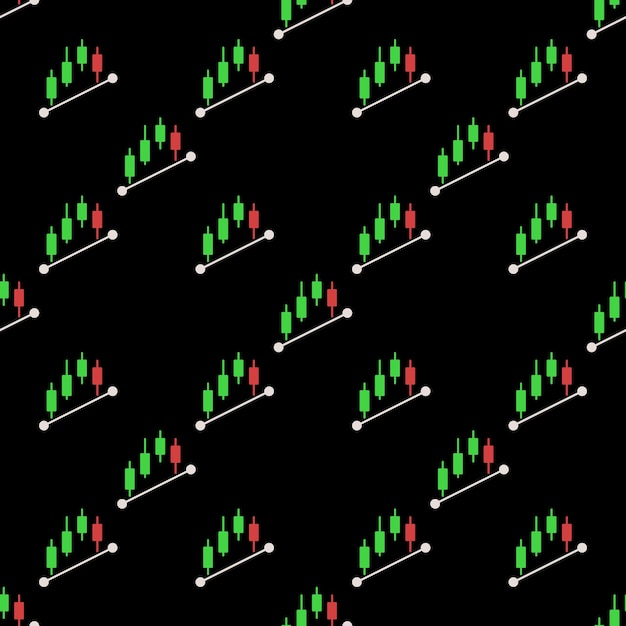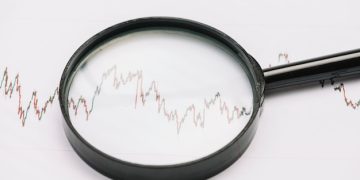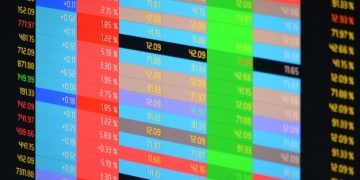Technical Analysis: Identifying Trends and Making Informed Decisions

Understanding and Utilizing Technical Analysis: A Guide to Identifying Trends and Making Informed Decisions involves analyzing historical market data to forecast future price movements and make informed investment decisions, offering a strategic approach to navigate the complexities of financial markets.
Navigating the financial markets can be daunting, but with the right tools, you can make informed investment decisions. Understanding and Utilizing Technical Analysis: A Guide to Identifying Trends and Making Informed Decisions offers a powerful framework for analyzing market data and predicting future price movements, thus enhancing your trading strategies.
What is Technical Analysis? A Comprehensive Overview
Technical analysis is a method of evaluating investments and identifying trading opportunities by analyzing statistical trends gathered from trading activity, such as price movement and volume. Unlike fundamental analysis, which examines a company’s financials, technical analysis focuses on historical market data to predict future price movements.
At its core, it believes that all known information about a company is already reflected in its stock price. Therefore, by studying price charts and various technical indicators, traders and investors can identify patterns and potential entry and exit points.
Key Principles of Technical Analysis
Several foundational principles underpin the practice of technical analysis, guiding practitioners in their approach to the markets.
- Market Discounts Everything: This principle suggests that all known information, including economic factors, political events, and company-specific news, is already reflected in the price of an asset.
- Price Moves in Trends: Technical analysts believe that prices tend to move in trends, which can be either upward, downward, or sideways. Identifying these trends is crucial for making informed trading decisions.
- History Tends to Repeat Itself: The theory of technical analysis suggests that certain patterns and formations in price charts tend to repeat over time. By recognizing these historical patterns, traders can anticipate future price movements.
Technical analysis provides a structured approach to understanding market behavior and making informed decisions based on price and volume data. By focusing on trends and patterns, traders and investors can refine their strategies and improve their chances of success in the financial markets.

Essential Tools and Indicators in Technical Analysis
Technical analysts rely on a variety of tools and indicators to interpret market data and identify potential trading opportunities. These tools range from simple trend lines to complex mathematical calculations, all designed to provide insights into price movements and market momentum.
Understanding these tools is essential for anyone looking to apply technical analysis effectively. Let’s explore some of the key tools and indicators used in technical analysis.
Moving Averages
Moving averages are one of the most basic and widely used tools in technical analysis. They smooth out price data by calculating the average price over a specified period. This helps to identify the direction of the trend and potential support and resistance levels.
Relative Strength Index (RSI)
The Relative Strength Index (RSI) is a momentum indicator that measures the magnitude of recent price changes to evaluate overbought or oversold conditions in the price of an asset. It oscillates between 0 and 100, with readings above 70 typically indicating overbought conditions and readings below 30 suggesting oversold conditions.
- Trend Lines: Trend lines are simple yet powerful tools used to identify the direction of a trend. They are drawn by connecting a series of highs in a downtrend or a series of lows in an uptrend.
- Support and Resistance Levels: Support levels are price levels where a stock tends to find support on its way down, while resistance levels are price levels where a stock tends to meet resistance on its way up.
- Volume Indicators: Volume indicators measure the amount of trading activity, providing insights into the strength of price movements. An increase in volume during a price move can confirm the strength of the trend.
These tools and indicators, when used in combination, can provide a comprehensive view of market dynamics, helping traders and investors make more informed decisions.
Understanding Chart Patterns for Trend Identification
Chart patterns are visual formations on price charts that can provide valuable insights into future price movements. These patterns are formed by price action over a period of time and can indicate potential trend reversals or continuations.
Recognizing and understanding these patterns can significantly enhance a trader’s ability to predict market behavior. Let’s delve into some of the most common chart patterns used in technical analysis.
Head and Shoulders
The Head and Shoulders pattern is a bearish reversal pattern that signals the end of an uptrend. It consists of a peak (the head) flanked by two lower peaks (the shoulders). The neckline, which connects the lows between the peaks, is a key level to watch for a breakdown.
Double Top and Double Bottom
The Double Top pattern is another bearish reversal pattern that occurs when a stock price attempts to break through a resistance level twice but fails. Conversely, the Double Bottom pattern is a bullish reversal pattern that occurs when a stock price attempts to break through a support level twice but fails.
- Triangles: Triangles are continuation patterns that indicate a period of consolidation before the price breaks out in the direction of the prevailing trend.
- Flags and Pennants: Flags and pennants are short-term continuation patterns that form after a strong price move. They represent a brief pause in the trend before it resumes.
- Wedges: Wedges are similar to triangles but have a more pronounced slope. They can be either rising or falling and can indicate potential trend reversals.
Mastering chart patterns allows traders to anticipate potential trend changes and make strategic entry and exit decisions based on the visual cues provided by price charts.

Applying Technical Analysis to Different Timeframes
Technical analysis can be applied to various timeframes, ranging from short-term intraday charts to long-term monthly charts. The timeframe chosen depends on the trader’s or investor’s goals and trading style.
Understanding how to adapt technical analysis techniques to different timeframes is crucial for effective trading. Let’s explore how technical analysis can be applied across different timeframes.
Short-Term Timeframes
Short-term timeframes, such as 5-minute, 15-minute, and hourly charts, are typically used by day traders who look to profit from small price movements throughout the day. Technical indicators like moving averages, RSI, and MACD are commonly used to identify short-term trends and trading opportunities.
Medium-Term Timeframes
Medium-term timeframes, such as daily and weekly charts, are favored by swing traders who hold positions for several days or weeks. These timeframes allow traders to identify broader trends and patterns while filtering out some of the noise associated with shorter-term charts.
- Long-Term Timeframes: Long-term timeframes, such as monthly and yearly charts, are used by long-term investors who seek to identify secular trends and make investment decisions based on macroeconomic factors.
- Combining Timeframes: Many traders and investors use a combination of different timeframes to gain a more comprehensive view of the market. Analyzing a stock on multiple timeframes can help confirm trends and identify potential entry and exit points.
- Adapting Strategies: It’s important to adapt your technical analysis strategies to the timeframe you are trading. What works on a short-term chart may not be effective on a long-term chart, and vice versa.
By understanding how to apply technical analysis across different timeframes, traders and investors can tailor their strategies to suit their individual goals and risk tolerance, ultimately enhancing their trading performance.
Risk Management Strategies in Technical Analysis
Risk management is a critical component of successful trading and investing. Technical analysis can be used to identify potential entry and exit points, but it’s equally important to implement strategies to protect your capital and minimize losses.
Effective risk management involves setting stop-loss orders, managing position sizes, and diversifying your portfolio. Let’s explore some key risk management strategies in technical analysis.
Setting Stop-Loss Orders
A stop-loss order is an order placed with a broker to buy or sell a stock once it reaches a certain price. Stop-loss orders are used to limit losses on a trade. In technical analysis, stop-loss orders are often placed based on support and resistance levels or chart patterns.
Managing Position Size
Position sizing involves determining the appropriate amount of capital to allocate to a single trade. A common rule of thumb is to risk no more than 1-2% of your total capital on any one trade. This helps to prevent significant losses from any single trade.
- Diversification: Diversifying your portfolio across different asset classes, sectors, and geographic regions can help to reduce overall risk. By diversifying, you are not overly exposed to any single investment.
- Using Leverage Wisely: Leverage can amplify both profits and losses. It’s important to use leverage cautiously and understand the risks involved.
- Emotional Discipline: One of the biggest challenges in trading is managing emotions. Fear and greed can lead to impulsive decisions that undermine your risk management strategies.
Implementing effective risk management strategies is essential for protecting your capital and ensuring long-term success in the financial markets. By combining technical analysis with sound risk management practices, traders and investors can navigate the markets with confidence and discipline.
Common Pitfalls to Avoid in Technical Analysis
While technical analysis can be a powerful tool for making informed investment decisions, it’s not without its limitations. There are several common pitfalls that traders and investors should be aware of and avoid.
Over-reliance on indicators, confirmation bias, and neglecting fundamental analysis are just a few of the mistakes that can lead to poor trading outcomes. Let’s examine some of the most common pitfalls to avoid in technical analysis.
Over-Reliance on Indicators
It’s tempting to rely solely on technical indicators to make trading decisions, but this can be a mistake. Indicators should be used as a guide, not as a substitute for independent thinking and judgment. Confirmation from multiple indicators can strengthen a signal, but no single indicator is foolproof.
Confirmation Bias
Confirmation bias is the tendency to seek out information that confirms your existing beliefs while ignoring information that contradicts them. In technical analysis, this can lead to cherry-picking data and ignoring warning signs that your trade may be going against you.
- Ignoring Fundamental Analysis: Technical analysis focuses on price and volume data, it’s important not to completely neglect fundamental analysis. Understanding the underlying factors that drive a company’s performance can provide valuable context for your technical analysis.
- Chasing the Market: Chasing the market involves making impulsive trades based on fear of missing out (FOMO) or greed. This can lead to buying high and selling low, which is a recipe for disaster.
- Failing to Adapt: The markets are constantly changing, and what worked in the past may not work in the future. It’s important to be flexible and adapt your strategies as market conditions evolve.
By being aware of these common pitfalls and taking steps to avoid them, traders and investors can improve their chances of success in the financial markets.
| Key Point | Brief Description |
|---|---|
| 📈 Trend Identification | Using chart patterns and indicators to spot market trends. |
| 📊 Technical Indicators | Tools like RSI and moving averages help analyze market data. |
| 🛡️ Risk Management | Setting stop-loss orders and managing position sizes to minimize risks. |
| ⏱️ Timeframe Application | Adapting technical analysis to different timeframes (short, medium, long-term). |
Frequently Asked Questions
▼
The goal is to forecast future price movements by analyzing historical market data, primarily price and volume, to make informed trading decisions.
▼
Technical analysis focuses on price charts and indicators, while fundamental analysis examines a company’s financials and economic factors.
▼
Common indicators include moving averages, RSI, MACD, and volume indicators, each providing different insights into market dynamics.
▼
It helps protect capital by setting stop-loss orders, managing position sizes, and diversifying portfolios to minimize potential losses.
▼
Avoid over-reliance on indicators, confirmation bias, ignoring fundamental analysis, and failing to adapt strategies to changing market conditions.
Conclusion
Mastering understanding and utilizing technical analysis: A guide to identifying trends and making informed decisions involves continuous learning and adaptation. By understanding the principles, tools, and strategies discussed, traders and investors can enhance their ability to navigate the complexities of the financial markets with confidence.





